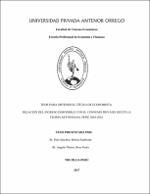| dc.contributor.advisor | Yupanqui Vaca, Jorge Luis | |
| dc.contributor.author | Polo Sanchez, Meliza Katherine | |
| dc.contributor.author | Angulo Ñamot, Rosa Paola | |
| dc.creator | Polo Sanchez, Meliza Katherine | |
| dc.date.accessioned | 2018-01-25T13:44:05Z | |
| dc.date.available | 2018-01-25T13:44:05Z | |
| dc.date.issued | 2017 | |
| dc.identifier.uri | https://hdl.handle.net/20.500.12759/3485 | |
| dc.description.abstract | La investigación ha tenido como objetivo general determinar la relación del ingreso
disponible con el consumo privado según la Teoría Keynesiana en el Perú durante el
periodo 2003-2016, dicha teoría postula que el ingreso disponible influye de manera
positiva en el consumo privado en un rango de 0 a 1. Para ello se ha tomado como
muestra los datos del ingreso disponible, el consumo privado, desde el año 2003 hasta el
año 2016; los cuales fueron recolectados del Banco Central de Reserva del Perú y
Superintendencia de Banca, Seguros y AFPS. Es un tipo de investigación no experimental
correlacional y explicativa. Las variables abordadas en el modelo son el ingreso
disponible, el consumo privado y la tasa de interés nominal.
Para lograr los objetivos propuestos se realizó un modelo econométrico multivarable. Los
resultados muestran que el ingreso influye positivamente sobre el consumo en el Perú
durante el periodo 2003- 2016. Siendo la propensión marginal a consumir 0.77, es decir
que por cada S/ 1.00 adicional de ingreso disponible, el consumo de las familias aumenta
en S/ 0.77. Estos resultados son acordes con la teoría económica keynesiana y la hipótesis
planteada en este trabajo. | es_PE |
| dc.description.abstract | The general objective of the research was to determine the relation of disposable income
to private consumption according to the Keynesian Theory in Peru during the period
2003-2016, this theory postulates that disposable income has a positive influence on
private consumption in a range of 0 to 1. For this purpose, the data on disposable income,
private consumption, from 2003 to 2016 have been taken as a sample; which were
collected from the Central Reserve Bank of Peru and Superintendence of Banking,
Insurance and AFPS. It is a type of correlational and explanatory non-experimental
research. The variables addressed in the model are disposable income, private
consumption and the nominal interest rate.
To achieve the proposed objectives, a multivariate econometric model was carried out.
The results show that income has a positive influence on consumption in Peru during the
period 2003-2016. Being the marginal propensity to consume 0.77, that is, for each
additional S / 1.00 of disposable income, the consumption of family’s increases in S /
0.77. These results are consistent with Keynesian economic theory and the hypothesis
presented in this paper. | en_US |
| dc.format | application/pdf | es_PE |
| dc.language.iso | spa | es_PE |
| dc.publisher | Universidad Privada Antenor Orrego - UPAO | es_PE |
| dc.relation.ispartofseries | T_ECON_093 | |
| dc.rights | info:eu-repo/semantics/openAccess | es_PE |
| dc.source | Universidad Privada Antenor Orrego | es_PE |
| dc.source | Repositorio Institucional - UPAO | es_PE |
| dc.subject | Consumo privado | es_PE |
| dc.subject | Ingreso disponible | es_PE |
| dc.title | Relación del ingreso disponible con el consumo privado según la teoría keynesiana. Perú 2003 - 2016 | es_PE |
| dc.type | info:eu-repo/semantics/bachelorThesis | es_PE |
| thesis.degree.level | Título Profesional | es_PE |
| thesis.degree.grantor | Universidad Privada Antenor Orrego. Facultad de Ciencias Económicas | es_PE |
| thesis.degree.name | Economista con Mención en Finanzas | es_PE |
| thesis.degree.discipline | Economía | es_PE |

